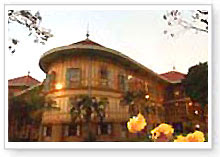Wat Phra Si Sanphet
In 1491, Wat Phra Si Sanphet was located inside the compound of the Grand Palace-the foundations of which are still visible-and served as the royal chapel, as Wat Phra Kaeo does in Bangkok. This Wang Lung Palace (Royal Palace) was built by King U-Thong upon the founding of the city. Used as a residential palace, it became a monastery in the reign of King Ramathibodi I. When King Borom Trai Lokanat commanded the construction of new living quarters, this residential palace was transformed into a temple,and the establishment of Wat Phra Si Sanphet. In Ayutthaya's heyday, this was the largest temple in the city.
The three main chedis which have been restored contain the ashes of three Ayutthaya kings. The temple is situated at the northern end of Si Sanphet Road. The royal chapel does not have any monks and novice inhabitants. Admission fee is 20 bahts.
 The Phra Nakhon Si Ayutthaya or Ayutthaya in short, is one of Thailand's historical and majestic highlights. Serving as the Thai capital for 417 years (1350 1767: Kingdom of Ayutthaya), it was once glorified as one of the biggest cities in Southeast Asia. During the 17th century, most foreign visitors to Ayutthaya, traders or diplomats alike, claimed Ayutthaya to be the most illustrious and glittering city that they had ever visited. The map of Ayutthaya published in 1691 by Simon de la Loubere in Du Royaume De Siam is proof of such recognition.
The Phra Nakhon Si Ayutthaya or Ayutthaya in short, is one of Thailand's historical and majestic highlights. Serving as the Thai capital for 417 years (1350 1767: Kingdom of Ayutthaya), it was once glorified as one of the biggest cities in Southeast Asia. During the 17th century, most foreign visitors to Ayutthaya, traders or diplomats alike, claimed Ayutthaya to be the most illustrious and glittering city that they had ever visited. The map of Ayutthaya published in 1691 by Simon de la Loubere in Du Royaume De Siam is proof of such recognition. The Kingdom of Ayutthaya was built and developed in leaps and bounds. The ruins in Ayutthaya that survived the test of time embody both the glorious and ignominious stories of the Kingdom.
The Kingdom of Ayutthaya was built and developed in leaps and bounds. The ruins in Ayutthaya that survived the test of time embody both the glorious and ignominious stories of the Kingdom.  Today, there are but groups of crumbling ruins and rows of headless Buddhas where once an empire thrived. The temple compounds are still awe-inspiring even in disrepair and a visit here is memorable and a good beginning for those drawn to the relics of history.
Today, there are but groups of crumbling ruins and rows of headless Buddhas where once an empire thrived. The temple compounds are still awe-inspiring even in disrepair and a visit here is memorable and a good beginning for those drawn to the relics of history.







 Situated on Thiam Ruammit Road off Ratchadaphisek Road, about 100 metres from the Thailand Culutral Center.
Situated on Thiam Ruammit Road off Ratchadaphisek Road, about 100 metres from the Thailand Culutral Center. This exquisite collection of traditional Thai house stands as a museum to the man who revived the Thai silk industry after the Second World War.
This exquisite collection of traditional Thai house stands as a museum to the man who revived the Thai silk industry after the Second World War. 


 A visit to Wat Suthat Thep Wararam, situated almost in the center of old Bangkok, gives you an opportunity to see both the Giant Swing and one of the first-class Royal temples. The surrounding area is also worth exploring as there are many shops selling religious items.
A visit to Wat Suthat Thep Wararam, situated almost in the center of old Bangkok, gives you an opportunity to see both the Giant Swing and one of the first-class Royal temples. The surrounding area is also worth exploring as there are many shops selling religious items. 
 A visit to the National Museum reveals the history of Thailand And how people lived during the different periods. It gives you a view through the windows of the past.
A visit to the National Museum reveals the history of Thailand And how people lived during the different periods. It gives you a view through the windows of the past.  Make sure you set aside one late afternoon to see and photograph this imposing sight at sunset with the Chao Phraya River in the foreground. These photographs will bring back beautiful memories of Bangkok.
Make sure you set aside one late afternoon to see and photograph this imposing sight at sunset with the Chao Phraya River in the foreground. These photographs will bring back beautiful memories of Bangkok.  This is possibly the most interesting temple in Thailand as it combines history, medical science and is a center for meditaion and traditional massage training. Its official name is Wat Phrachetuphon Vimon Mangkararam Ratchaworamahawihan, although it is commonly called Wat Po.
This is possibly the most interesting temple in Thailand as it combines history, medical science and is a center for meditaion and traditional massage training. Its official name is Wat Phrachetuphon Vimon Mangkararam Ratchaworamahawihan, although it is commonly called Wat Po.  Every visitor to Bangkok should see the magnificent buildings within the Grand Palace compound to get a feeling of the grandeur architectural style.
Every visitor to Bangkok should see the magnificent buildings within the Grand Palace compound to get a feeling of the grandeur architectural style.







